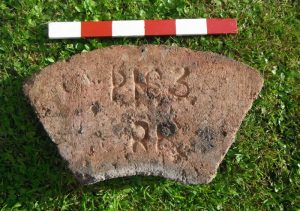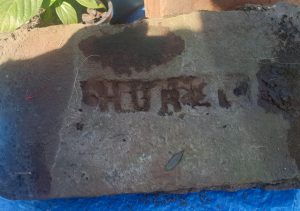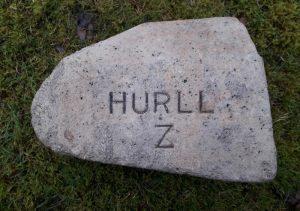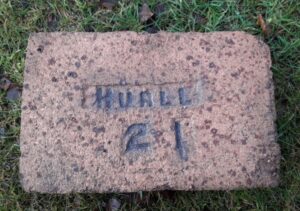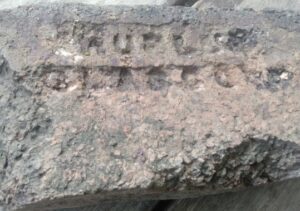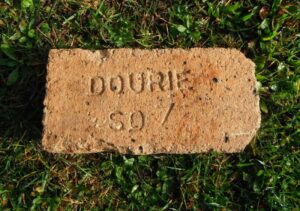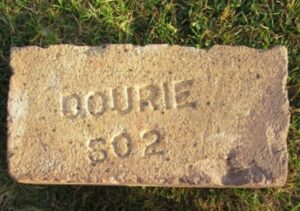Garnqueen Fireclay Works, Glenboig, Lanarkshire.
Gartliston Fireclay Works, Glenboig, Lanarkshire.
Gartliston (opened 1889) and Garnqueen (opened 1895) which was closer to Glenboig village, being about 1 mile south-east of the village.
Canmore – Gartliston.
Canmore – Garnqueen.
P & M Hurll Ltd owned Birkhill Clay Mine in Bo’ness. Birkhill Clay Mine had high-quality fireclay deposits which have been exploited since the 18th century. The partnership of P & M Hurll Ltd, Glenboig, was established around 1887. Mark Hurll, a firebrick manufacturer from Glenboig, Lanarkshire, leased Birkhill from Hamilton Estates in 1908 and the company took over the mine in 1916. P & M Hurll went into liquidation in July 1980.
Mark Hurll jun. (of Peter & Mark Hurll, Ltd.) Ho., 1109 Aikenhead road, S.4. Hurll, Peter & Mark, Ltd., manufacturers of firebricks, furnace blocks, gas retorts and fittings, Gartliston and Garnqueen Works, Glenboig. Also building Bricks at Garscadden Works, Drumchapel; office, 144 W. Regent St. C.2; depot, St, Rollox; Tel. No., 147 Douglas; telegrams, ” Hurll, Glasgow.” Hurll, Thomas R. C. (Peter & Mark Hurll, Ltd.); Ho., Braeriach, Boclair Cres, Bearsden.
Gartliston Fireclay Mine – Situated near Glenboig.
The employees mostly reside in mine owners’ houses situated at Glenboig, known as Gartliston Square and Garnqueen Square
The new houses are described as follows: – 20 houses – 12 one apartment, rental £5 19s 2d including rates and doctors attendance; and 8 two-apartment houses, rental £7 13s 10d, including rates. Seventeen of the houses have a scullery – These houses were erected about 16 years ago – One storey, brick-built – no damp-proof course – Outside walls strapped and lathed – floors wood, ventilated – internal surface of walls and ceilings in good condition.
- No overcrowding
- No gardens – wash house in common with other houses – coal cellar for each house.
- Privy midden with two seats, not sufficiently private
- 1 house with sink and water supply to same – surface channels, thence underground to the loch
- Gravitation water supply from the standpipe at the west end of the property
- Scavenged at owners’ expense
- Repairs have been carried out from time to time at the request of the Public Health Department”
-
The two Hurll’s works, Gartliston and Garnqueen sat either side of the Glasgow to Perth railway line. Garnqueen lay on the top and south-east side of a hill to the south of the village of Glenboig while Gartliston lay in the slight hollow to the south-west of Garnqueen and to the south of the housing area of Ramoan, about one mile from Glenboig on the Coatbridge side. (See map at the end of the document) Tucked away some mile or so west of the main Glenboig to Ramoan Road, the Gartliston works could hardly be seen by those who didn’t know it was there. Only from the train did you get a good look at it. A distant view could be obtained as you drove up the hill to approach Ramoan from Coatbridge. Both works had originally had their own deep mines but the Garnqueen one closed and the air shaft, capped by a vented steel plate could still be seen on the south side of the site near to the Mine Manager’s house. According to the mining maps, this was only some 90 feet (27 metres) deep.
The Gartliston Brickworks consisted of the following:- a pit (a deep mine some 200 feet, (61 metres deep) which provided the fireclay, a boiler house which used coal to provide heating (needed for the bricks and other equipment, not the workers), the crusher, grinding and mixing mills, the sheds where the semi-automatic machines produced standard, uncomplicated bricks and the hand-brick-making sheds (known for some reason a “stoves”, though I guess the bricks were “baked” dry!). The latter buildings were a single storey but the sloping roof space, or loft, space was also used, in the case of the “big stove” for brick making/brick drying. Thus the upper floor became known as the “Loft” or “Laft in local parlance.
- Records showed that in 1896 there were 36 miners employed in the Gartliston pit.
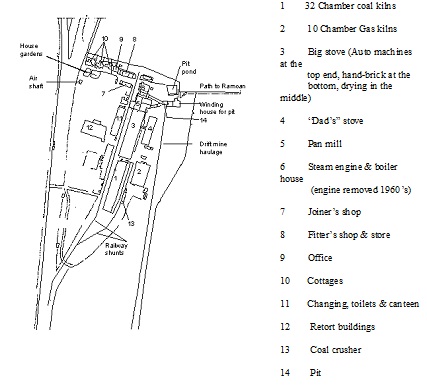

Below – 1858 – Glenboig – How the land looked before the brickworks.
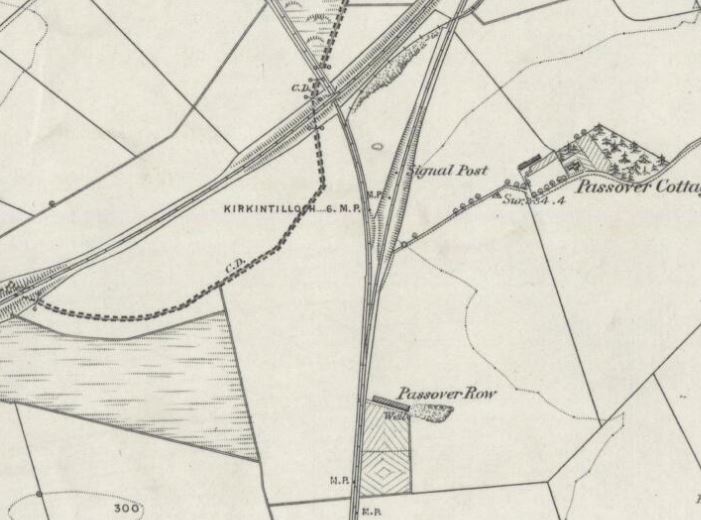
Below – 29/07/1889 – Glasgow Evening Post – Announcing that the Gartliston Fire Clay Works will soon be opened by the proprietor Peter Hurll.

23/09/1890 – Edinburgh Evening News – Fire broke out in the oil store and joiners shop at Gartliston Fireclay Works, Glenboig last night belonging to Mr Peter Hurll. The fire lasted 2 hours and the premises were completely gutted. A large quantity of oil, wood and tools were destroyed. The damage which is serious is covered by insurance.
1890 –1891 – Gartliston Fireclay Works, Glenboig. Office 95 Bath Street. Depot St Rollox.
1890 – 1891 – Peter Hurll, Gartliston Fireclay Works, Glenboig. Office 95 Bath Street
24/09/1890 – Glasgow Herald – Glenboig – Destructive Fire – Late on Monday night a destructive fire occurred at the Gartliston Fireclay Works belonging to Peter Hurll. The fire originated in an oil store and spread to the joiners workshop. A large force of workmen with a plentiful supply of water managed to confine the flames to these premises which, however, were completely gutted. The damage is considerable but the loss is covered by insurance.
1893 – 1894 – Gartliston Fire Clay Works; Office, 95 Bath St.
1894 – 1895 – Gartliston Fire Clay Works; Office, 95 Bath St.
05/09/1895 – Glasgow Evening Post – Contravention of Friendly Society Act. Prosecution at Airdrie. At Airdrie today, John Hurll, Treasurer of the Gartliston and Garnqueen Friendly Society admitted having paid the funeral costs for a child without receiving a registrars certificate of the death in terms of the Friendly Society’s Act. It was stated that these cases were becoming frequent and the registrar general wanted the practice stopped. The minimum penalty of 30s was imposed.
Below – 1896 – Gartliston and Garnqueen Brickworks, Glenboig

03/06/1896 – Glasgow Herald – Joiner wanted accustomed to pit work – Apply P & M Hurll, Gartliston Works, Glenboig. or 144 West Regent Street, Glasgow.
1897 – 1898 – Gartliston and Garnqueen Fire Clay Works, Glenboig, Peter & Mark Hurll; office, 144 West Regent St.; depot, head of Glebe Street, St. Rollox; telephone No. 147.
1898 – 1899 – Gartliston and Garnqueen Fire Clay Works, Glenboig, Peter & Mark Hurll; office, 144 West Regent St.; depot, head of Glebe Street, St. Rollox; telephone No. 147.
1899 – 1900 – Gartliston and Garnqueen Fire Clay Works, Glenboig, Peter & Mark Hurll; office, 144 West Regent St.; depot, head of Glebe Street, St. Rollox; telephone No. 147.
1899 – 1900 – Peter and Mark Hurll manufacturers of fire bricks, furnace blocks, gas retorts and fittings, Gartliston and Garnqueen Works, Glenboig. Office 144 West Regent Street. Depot St Rollox. Telephone no 147. Telegram ‘Hurll’ Glasgow.
21/02/1899 – Dundee Advertiser – The personality of Mr John Hurll, Woodneuk, Gartcosh has been returned at £119,495.
04/10/1899 – Glasgow Herald – Clerk wanted for a Fire Brick Depot, St Rollox. (With experience preferred). Apply to P & M Hurle (Hurll), 144 West Regent Street, Glasgow.
Below – c. 1900 – Culturenlmuseums – Fireclay Mine Hutch, 1900s. Used by miners at P & M Hurll’s Brickwork’s, Gartliston to transport the fireclay direct to the brickworks which were on the same site. The pit was sunk in 1888 and was very deep; 200 feet (61 metres) to be exact. Hurll’s also owned Garnqueen Fireclay Works near Glenboig and the Manuel Works, Linlithgow.

Below – c. 1900 – Culturenlmuseums – Used at Hurll’s Brickwork’s, Gartliston to transport the clay from the mine to the brickworks. The body could be tipped while the wheels remained in the rails.

28/04/1900 – Airdrie and Coatbridge Advertiser – Assault in brickwork. At Airdrie J.P. Court on Thursday, James McMahon, labourer, 8 Passover Row, Glenboig, was charged with assaulting another labourer in the retort kilns in Gartliston Brickwork, on Monday, 16th April. The accused was fined 10s. or seven days.
13/03/1901 – Kirkintilloch Herald – Miners strike. The fire clay miners employed by Messrs Dunnachie at Glenboig and Gartcosh; Messrs Hurll at Gartliston; and Mr Phaill (Faill?) at Heathfield, Garnkirk have come out. The men some time ago made a demand for an increase of 4d per ton. This the masters refused to grant. The fireclay miners then joined the Lanarkshire Miners County Union, and negotiations were commenced on behalf of the men by Mr Gilmour. On Saturday the demand was modified to an increase of 1 1/2d per ton. Almost simultaneously with this, the masters posted up a notice of a reduction of a penny per ton, with the result that Mr Gilmour has brought the miners out. The number of miners engaged at Glenboig, Gartcosh, Gartliston and Heathfield number about 250. The effect of the strike is likely to throw all the brickworks at these places idle soon as the present surplus stock of fire clay is used up and will consequently cause a very large number of men employed as moulders, burners, etc., to be idle.
20/03/1901 – Kirkintilloch Herald – Wanted. Miners to keep away from Glenboig, Gartliston, Gartcosh and Heathfield Fireclay Pits during the present dispute.
04/04/1901 – Dundee Courier – Sharp sentence – Before Sheriff Mair at Airdrie, Michael O’Shea fireclay miner, Glenboig was tried under the Conspiracy and Protection of Property Act with having on 27th March with a view to compelling James Delaney and Frank Martin residing in Carrick Street, Glasgow to abstain from working in Hurll’s Gartliston Fireclay mines, along with a large crowd, shouted and booed and called them ‘blacklegs’ and throwing stones at these men. A large number of witnesses were examined on both sides. The Sheriff found the charge proven and characterising it as a very bad case, passed a sentence of 3 months imprisonment with hard labour.
Robert Sloan, Clay miner, Glenboig and Michael Lorin, drawer, Glenboig were then tried on a similar charge on Friday by besetting 2 of the workmen who came from Coatbridge. As it appeared they were ignorant that by following up the men on the streets of that town they were guilty of contravening the Act, the Sheriff let them go with a severe caution.
20/07/1901 – Kirkintilloch Gazette – Glenboig – Contracts have been signed by the Glenboig Union Fireclay Company and P & M Hurll with Mr Graeme Hunter for the supply of workmen for the clay mines at Glenboig, Garnqueen, Gartliston, Gartcosh and Heathfield for a period of 3 years. Mr Hunter has secured or is to secure all the houses of the evicted parties. Those already secured have been furnished and men employed by him are lodged there. A number of new workers are expected from Dundee in a day or two.
1901 – 1902 – Gartliston and Garnqueen Fire Clay Works, Glenboig, Peter & Mark Hurll; Office, 144 West Regent St.; Depot, head of Glebe Street, St. Rollox; telephone No. 147.
Jan 1907 – Invoice – Peter and Mark Hurll, Gartliston and Garnqueen Fire Clay Works, Glenboig and Garscube and Knightswood Brick and Sanitary Pipe Works near Maryhill. Office 144 West Regent Street, Glasgow.
09/09/1908 – Kirkintilloch Herald – New Company Among the new joint-stock companies registered last month was that of Peter and Mark Hurll, brick manufacturers. Capital £50,000 divided into 25,000 six per cent cumulative preference shares of £1 each and 25,000 ordinary shares of £1 each. First subscribers Peter Hurll, 144 West Regent Street, Glasgow, Mark Hurll, do, Emily Francois Duvoison and John Henry Hurll, Romoan House, Glenboig.
29/09/1909 – Coatbridge Express – Five tramps from Gartliston Brickworks were sent down for a bath to Glasgow Prison from the County Court on Monday. This class of ‘K. C. B.” has been very common in the district for some time and is a reflex of the state of trade and the scarcity of money among the ‘gangrels’.
18/08/1911 – The Kirkintilloch Gazette – Chryston – Death of County Councillor Hurll – The death occurred at Woodneuk, Gartcosh on Monday of Mr Peter Hurll of the well-known firm of fireclay manufacturers. Peter and Mark Hurll Ltd. Mr Hurll was in his 70th year and up until a month or two ago was actively involved in the business. On the advice of his medical advisor, he relinquished his duties and contemplated going off for a change and extended rest. On the retiral of Mr W.C.B Christie of Bedlay from Lanarkshire County Council, Mr Hurll acceded to a request from all sections of the community to come forward as the representative for the Chryston Ward in the County Council and was returned unopposed in November 1909. Mr Hurll led a strenuous life and while acting as Managing Director of P & M Hurll, attended very assiduously to the duties which devolved on him in his public capacity… The funeral took place yesterday to Bedlay Cemetery.
06/03/1912 – Kirkintilloch Herald – … The strike is having a serious effect on the other industries in the district, work having been suspended at the works of Heathfield and Cardowan Fireclay Co Ltd, Heathfield; The Glenboig Union Fireclay Coy Ltd at Gartcosh, Glenboig and Cumbernauld; Messrs P & M Hurll’s Ltd Brickworks, Glenboig …
24/08/1912 – Airdrie and Coatbridge Advertiser – Glenboig brickworks and pits are thrown idle. The torrential rains experienced during the last few days have done much damage in the Glenboig district, and among the sufferers in this respect are Messrs P and M Hurll, firebrick manufacturers, Glenboig whose pits and works situated at Garnqueen are completely stopped owing to subsidence and the flooding of their pit workings. The occurrence took place on Tuesday morning and is similar to an accident at the same place on January 23 last, but this time the damage is more extensive, and it will require days of strenuous labour to place everything in working order. The abyss caused by the subsidence is about 150 feet in diameter and 50 feet deep. Messrs Hurll have circularised their customers of the stoppage, and that neither labour nor experts are being spared to have the works set agoing. The water completely flooded all the low-lying workings and was four feet up the shaft but special pumps are being placed which should be able to throw large volumes of water to the surface. It has also been arranged to double shift the Gartliston works and pits so that their customers will be treated to the minimum of inconvenience.
11/12/1912 – Kirkintilloch Herald – Fireclay miners and drawers wanted: miners 6 shillings and sixpence to 8 shillings and sixpence per day, 6 days per week. Apply to P & M Hurll Ltd, Gartliston and Garnqueen Fireclay Works, Glenboig.
22/01/1913 – The Scotsman – Pit fireman fined. At Airdrie Sheriff Court yesterday, George Peters, pit fireman, Glenboig pleaded guilty to a contravention of the mines regulation act and special rule 126B by failing to inspect the working places of two miners before they proceeded to work therein in the Gartliston Fireclay Pit, Glenboig. It was pointed out that there might have been an accumulation of gas, and that there was danger of an explosion through no provision being made to prevent it. The Sheriff imposed the modified fine of £3 or 5 days.
22/05/1914 – Bellshill Speaker – Man killed at Glenboig. Another roof fall. A fatal accident involving the death of one man and serious injury to another, occurred on Tuesday in the Gartnifton Pit, Glenboig (Gartliston?) belonging to P and N Hurll Limited, fire brick manufacturers. (P and M Hurll). Matthew Neary unmarried, a drawer and John Lawless, married, a miner both belonging to Garnqueen Square, Glenboig were working together when a fall occurred from the roof. Neary was killed and Lawless was injured about the body. This is the first fatal accident that has occurred in the pit for over 20 years.
10/03/1920 – Falkirk Herald – Blockmakers wanted for fire clay works. Apply to P & M Hurll Ltd, Gartliston Fire Clay Works, Glenboig.
03/05/1921 – Dundee Courier – Gartsherrie – Lanarkshire Estate was recently exposed and the results of the sale were … Several lots which remain to be sold include Gartliston Fireclay Works and minerals …
13/01/1923 – Falkirk Herald – Pony for sale. In good condition, age 4 1/2 years. 13 hands high. Apply Peter and Mark Hurll Ltd, Gartliston Works, Glenboig.
29/06/1928 – Milngavie and Bearsden Herald – Temple. Sudden death of Mr Mark Hurll. Mr Mark Hurll, chairman of the firm of Messrs Peter and Mark Hurll Limited, brick manufacturers, Glasgow died suddenly on holiday at Hillswick, Shetland on Thursday. He was a keen angler and had made several trips to Shetland in pursuit of his favourite sport. Mr Hurll was a Lanarkshire man, about 78 years of age. and spent his early days in the Garnkirk district. In the early seventies, he became associated with the firm Messrs Hurll, Young and Co who had a brick-making establishment in Glenboig. He was connected also with the coal industry having been interested for many years in collieries in the Blantyre district. In the latter years of his life, he was associated with the Mount Vernon Colliery Company. Mr Hurll is succeeded in the brick-making business by two of his sons, Mr Mark Hurll and Mr Thomas R. C. Hurll.
Below – 29/06/1928 – Kirkintilloch Gazette – Death of a well-known brickmaker. On Thursday last week Mr Mark Hurll, chairman of Messrs Peter and Mark Hurll Ltd, the well-known brickmakers, died suddenly at Hillsurch, Shetland where he was on a fishing holiday. The deceased who was 78 years of age was a Lanarkshire man. His youth was spent in the Garnkirk district but after training as an engineer he spent some time in Germany. Returning to this country in the early seventies he became associated with the firm Messrs Hurll, Young and Co who had a brick-making establishment in Glenboig. He remained in the business at Glenboig until about 1888 when in company with his brother Mr Peter Hurll he founded the present Glasgow firm which later was registered as a limited company. Mr Hurll was also interested in the coal industry. In his business which has works at Glenboig and Drumchapel, he is succeeded by his sons Messrs Mark and Thomas R. C. Hurll.
11/01/1929 – Milngavie and Bearsden Herald – To mark the occasion of his appointment as managing director of the firm P & M Hurll Ltd, fire brick manufacturers, Glenboig, the workers of Gartliston and Garnqueen works met Mr Mark Hurll and presented him with a beautiful gramophone and records.
23/06/1933 – The Scotsman – Clay Miner Killed At Glenboig – A clay miner named John Gardner Fowler (23), who lived with his parents at 16 Gartliston Square, Glenboig, was firing a shot of compressed powder in No. 15 clay mine, Gartliston, when the shot suddenly went off, and he was caught in the flying debris. He sustained a fracture of the skull and other injuries, from which he died in the Glasgow Royal Infirmary.
Below – 1935 – 1936 – Gartliston and Garnqueen Brickworks, Glenboig
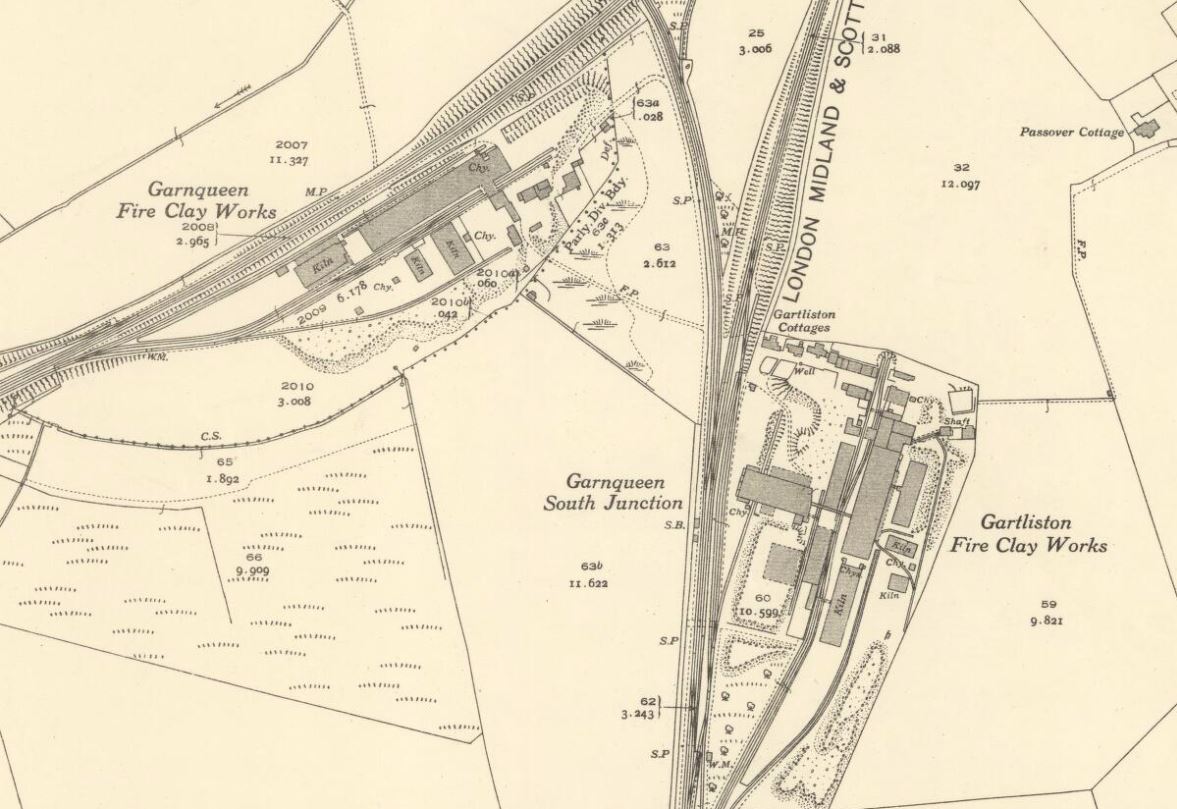
24/08/1935 – Coatbridge Leader – Big order for Glenboig. Two hundred thousand bricks. Winters work assured for villagers. Messrs P. and M. Hurll Ltd., firebrick manufacturers, Gartliston Works, Glenboig announced this week that they have received an order from an overseas corporation tor the supply of almost 200,000 bricks of various sizes. This latest order, it is understood, will ensure employment for many men and women throughout the winter. Contracts for ironworks in the English Midlands and Belgium have resulted in the Gartliston Works being at full pressure for some time past. It is interesting also to know that the Glenboig firm’s works at Garscadden, where building bricks are manufactured, have also been extremely busy. To cope with the rush of orders, indeed, a nightshift has had to be put on, and more than 300,000 bricks are being despatched every week for building schemes in Scotland and Ireland.
Below – 01/02/1936 – Airdrie and Coatbridge advertiser – George Sloan honoured for long service at Gartliston Fireclay Works.

Below – 1944 – 1967 – Gartliston Fireclay Works.

17/03/1947 – Dundee Evening Telegraph – Brick trade needs more machinery. The first report of the Technical Committee of the National Brick Advisory Council, which is issued today as a White Paper, estimates that it should be possible to produce the pre-war output of bricks with between 6000 and 15,000 operatives fewer than the pre-war labour force of 53,000 by making more use of machinery. The Ministry of Works are urged to arrange priority for orders for excavating, conveying and brick-making plant, assist manufacturers to obtain labour and raw materials, and consider whether manufacturing capacity and facilities are adequate. Although mechanical excavation was introduced in 1907, 70 per cent, of the brickworks still adhere to manual methods of winning clay. The report gives as an illustration that while a man engaged in full-time hand wheeling to a kiln may walk 10 miles a day and move 40 tons of bricks, a mechanical truck should handle 130,000 bricks a week and replace three unskilled workers with one skilled worker. Both sides of the industry were represented on the committee, whose chairman was Mr Lockhart W. Hutson, F.R.1.8.A., Hamilton. Mr T. R. C. Hurll, of P. B. M. Hurll, Coatbridge, was the other Scottish member of the committee. (Note – SBH – I assume P B M Hurll should read P & M Hurll).
22/05/1948 – Airdrie and Coatbridge Advertiser – A Coatbridge girl, Helen Docherty, 19 years who threw an iron nut into a machine at Glenboig Brickworks wrecking it in order to get a shift off work was fined £10 at Airdrie Sheriff Court. The incident happened at the Gartliston Brickworks. Mr A. Hurll, Managing Director of the works estimated the cost of damage to the machine as £41 4s and the loss of production as £98.
1980 – The 1985 publication ‘A survey of Scottish brickmarks’ suggests the works closed at this time.
Below – Peter and Mark Hurll Ltd, Glenboig Coatbridge, Scotland – A blank delivery note.

.
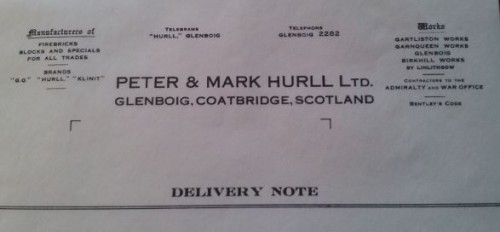
Note the reference to Bentleys Code –
- Bentleys Second Phrase The “Bentleys Code Phrases” [ http://www.archive.org/details/bentleyscomplete00bentuoft ] first published in 1906 continued to be commonly used till the end of the 1960s. That and other codes were widely used by commercial establishments. “Coding” was popular then at grass root levels. If the 5 letter codes were well understood, popular and used widely, there are no reasons why the present coding done with computer languages based on 8-bit octets cant be used with the same ease by the general public. Coding languages need to start circulating widely among the public the way Bentleys Code ruled from 1906 to the 1960s.
- Bentleys Code: A sample Genesis: In the late 19th and earlier 20th Centuries, there were Code Books created because telegram messages were charged by the word. As many as ten characters in a grouping were considered a word by the telegraph companies. Commercial Code Books, such as the Acme Code Words, or the Bentleys Complete Phrase Code were available to companies, enabling them to send complex messages in only a few “words.” Sample: For instance, if someone used Bentley’s phrasebook, he or she might choose the following letter groupings: DIZUH (contracts for) DAELF (computing) FEAVO (equipment) RUGUB (has/have been signed) KUKIB (New York) CUGYA (commence) OKGAP (production) ICSCO (immediately). Thus, the message, DIZUHDAELF FEAVORIGUB KUKIBCUGYA OKGAPICSCO, four “words,” would translate to, “Contracts for computing equipment have been signed [in] New York. Commence production immediately.” This would be in place of 12 normal words (13 if the implied “in” is included); a savings of at least 75 per cent. Of course, for someone without the Code Book, the message would be unreadable, but the message was sent primarily for the economy, not security.
Below – Illustrated catalogue (date unknown) – ‘HURLL’ Firebricks, covers etc – Peter and Mark Hurll Limited, Glenboig, Coatbridge, Scotland.

PETER & MARK HURLL
LIMITED,
GLENBOIG,
COATBRIDGE, SCOTLAND
TELEGRAMS AND CABLES . . . “HURLL, GLENBOIG”
TELEPHONE . . . . . . . . . GLENBOIG 2282
Code Used: BENTLEY’S
Shipping Ports
CLYDE AND FORTH
BRANDS REGISTERED
“HURLL” “KLINIT”
ON ADMIRALTY AND WAR OFFICE LISTS
Works
GARTLISTON FIREBRICK WORKS
AND
GARNQUEEN FIREBRICK WORKS
GLENBOIG
LANARKSHIRE
————
BIRKHILL FIRECLAY WORKS
BY LINLITHGOW
WEST LOTHIAN
Peter and Mark Hurll Limited – During the last hundred years, the name Hurll has been prominent in the history of the development of the Scottish firebrick industry, which in that time has built up at home and abroad a well-deserved reputation for the excellence of its products.
This long association with the industry started about 1835 when Mr John Hurll was first associated with the Garnkirk Fireclay Company, whose “Garnkirk” brand of firebrick was probably the first well-known Scottish firebrick.
In 1852 Mr John Hurll joined the partnership with Mr John Young, also of the Garnkirk Company, to form the firm of Hurll, Young & Company. The first works built and operated by this firm were Cardowan Fireclay Works, but the rapid expansion of their business led to the acquisition in 1860 of Heathfield Works from Messrs Miller & Ferguson, and the purchase in 1865 of Glenboig Works from Messrs Thomson, McLean & Company.
Fireclay had been first worked at Glenboig in 1836, but development had been so slight that in 1860 the population of Glenboig’s village was only about 120. The Glenboig Works were carried on under the control of Hurll, Young & Company until 1874 when the partnership was dissolved, Mr John Hurll purchasing the Glenboig Works and Mr Young purchasing Heathfield and Cardowan Works.
During the period of control by the original firm, and later while controlled by Mr John Hurll as an individual, the works extended rapidly, and by 1882-when Mr Hurll sold the Glenboig Works and retired-had become the best-known Fireclay works in Britain with a worldwide reputation for the excellence of their products.
In 1888 two sons of Mr John Hurll, Mr Peter Hurll and Mr Mark Hurll, both of whom had a complete knowledge of the organisation and management of the older works, entered into a partnership. Gartliston Pit was sunk half a mile to the south of Glenboig Station to the Glenboig Fireclay in the lower Millstone Grit, and Gartliston Works were built. A sound connection was very quickly built upon the merits of the products of the works, as the raw fireclay proved to be of excellent quality and the methods of manufacture and business outlook of the new partnership thoroughly up to date.
The steadily increasing demand for “HURLL” firebricks, as the products of Gartliston Works are known, was met by the sinking of a second pit at Glenboig in 1895, and the building of Garnqueen Works. Further developments followed in 1908 when a seam of Fireclay near Manuel, Linlithgowshire, which had been worked to a very small extent in the middle of the last century, was investigated. This clay proved to be highly aluminous and of very constant composition peculiar to this district. A mine was driven and firebricks from this clay are now marketed under the brand “KLINIT,” These bricks have set a new standard in high melting point natural aluminous refractories without admixture of other material.
In each district, only the true first-quality seam is worked, and the raw material is selected to maintain the quality of the product at a uniformly high standard. Modern plant is installed and maintained in the works to produce only sound, well-shaped, and hard-burned refractories.
The “HURLL” bricks, blocks, and retorts manufactured at our Gartliston and our Garnqueen Works, Glenboig, are justly favoured in Britain and its Colonies, on the Continent of Europe, and in many countries abroad for their long life when subjected to high or rapidly varying temperatures. It is very noteworthy that these bricks do not “spall” or break in the furnace, hence there is no weakening of the brickwork or damage to the contents of the furnace from falling pieces. The material manufactured and burned by us has a minimum of expansion or contraction.
Suitable grades produced are used by leading firms for steel and iron furnaces and ladles, stoves, cupolas, pottery kilns, chemical and glass furnaces, locomotives, fire-tube and water-tube boilers.
The “KLINIT” bricks are used where conditions are exceptionally severe, and there is a rapidly increasing demand for bricks made from this clay. Where pulverised coal or oil fuel is used or where it is of first importance that a furnace should be kept under heat continuously for long periods, these bricks are unrivalled. The remarkably high thermal stability records, measured by Seger Cones, are noteworthy, as they reach the unusually high figure of Cone 34-35
Below – Railway wagon label for ground fireclay from P & M Hurll Ltd, Manuel.

Below – Tombstone Bedlay Cemetery, Chryston, Glasgow – In affectionate remembrance of Isabella McGlashan wife of John Hurll of Woodneuk who died on 09/08/1874. Her children arise up and call her blessed, her husband also and be praised together. John Hurll of Woodneuk, born 12/11/1812 died 27/12/1898, Amy wife of Alexander Hurll, Bearsden died 13/02/1925. Mary Hurll died 18/12/1925. The above Alexander Hurll died 25/05/1929.

















